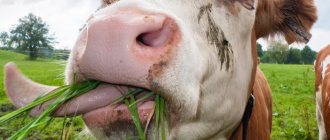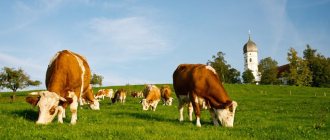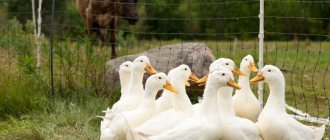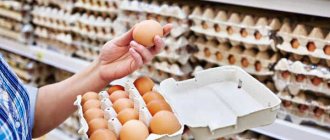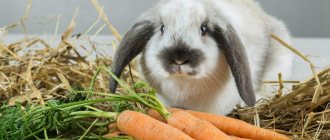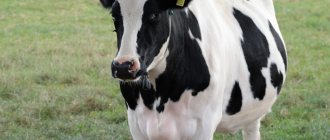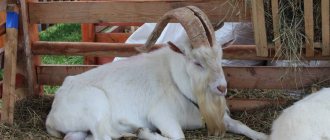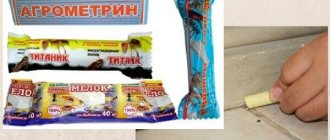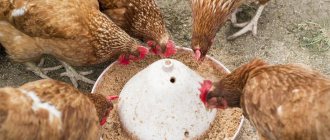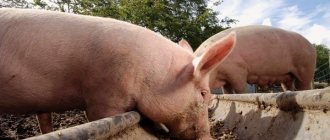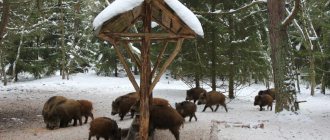Nutritious and balanced feed is the key to high milk production. To develop feeding rations, special standards are used based on the nutritional needs of cows.
Every day, each individual must consume a certain amount of proteins, amino acids, fiber, starch, fats, sugar, vitamins, trace elements and minerals. But since it is quite problematic to accurately determine the intake of certain elements, nutrition algorithms for cattle are developed taking into account only basic indicators. In this article you will find tables with approximate rations for cows for independently creating a livestock nutrition schedule.
- What should it be like?
Cattle feeding standards
In order for a dairy cow to produce a large amount of product every day, it is fed more than just grass and hay. Optimal nutrition in this case consists of different types of feed. For the health of the animal, it must be provided with wet and dry food and all the necessary dietary supplements every day.
According to the production method, feed is distinguished:
- animals;
- vegetable;
- combined;
- dietary supplements with vitamins and minerals.
The main components of the cattle diet are plant foods, of which there are 4 types:
- Juicy. This is grazing in the meadow, haymaking, various vegetables, any pumpkins, and silage in winter. These products provide cows with protein and fiber.
- Rough. Mostly it is dry haylage or straw. They are rich in vitamins and fiber. Along with grazing and root crops, roughage is the main food product for cattle.
- Concentrated. These are grain crops, cakes, bran, coarse cereals. By giving such supplements, you saturate the livestock’s body with proteins and carbohydrates.
- Animal feed. These are additives from fishery waste and meat processing plants. They are the only source of amino acids the animal needs. Meat, blood and fish meal make the cattle diet balanced in micro- and macroelements.
Artificial increase in body weight
Any cattle farmer must ensure that the calf is fed colostrum after birth. This product is characterized by the presence of all the vitamin and mineral elements necessary for the formation of a strong immune system. Its distinctive feature is the increased content of proteins involved in creating a strong body.
In order for a young body to grow and develop faster, certain points need to be taken into account when feeding. Young bulls should be fed up to 6 times a day. Many livestock breeders resort to artificial feeding using a special bottle with a nipple. The main condition in this case is the size of the puncture in the nipple, so that when soldering you do not have to face problems such as:
- reducing the sucking reflex;
- formation of a curdled mass in the abomasum;
- more milk entering the stomach per dose.
It is better to feed animals with fresh milk at this age, although, according to some breeders, defrosted milk, preheated to 38°, is also suitable. Some farmers practice feeding milk products collected from several cows.
What to feed a dairy cow
High-yielding cattle move very slowly and are very calm. In one day, a cow can eat up to 100 kg. haymaking and produce up to 25 liters. milk.
The diet of the average individual may consist entirely of large amounts of fresh grass or hay, with a small addition of carbohydrates and protein. But cows with a high level of milk yield need a diet rich in proteins, minerals, and proteins. Such food makes it possible to obtain very fatty milk.
The diet of such cows should consist of the following elements in the required quantities:
- high-quality natural feed;
- grass, hay, root crops;
- mineral and vitamin supplements;
- buttermilk, flour and whey from dairy, meat and fish production waste;
- concentrates;
- products of chemical origin and biosynthesis.
What to feed dairy cattle in winter?
Grazing of livestock in winter is not available; it is replaced with wet (vegetables, silage) and dry (straw, hay) products.
Along with the mentioned feeds, the cow must eat concentrates. Each unit of cattle should eat 10-12 kg per day. stern. In order for this amount of food to be well absorbed, it is divided into 5-6 meals per day.
During the cold period, the main portion of concentrated food is fed to the cow after milking. Silage cannot be consumed without other food; it must be combined with roughage.
Also, you cannot feed the same silage for a long time; you need to combine different types of feed (silage from sunflower, rapeseed, sorghum, Jerusalem artichoke). Otherwise, eating any one type of food for 1-1.5 months will lead to digestive upset in the animal.
In addition to roughage, during one meal in winter, a cow should receive:
- at least 3 kg of fodder beets;
- at least 1 kg of concentrated feed;
- 1 kg pulp.
How to replace silage?
Sometimes alfalfa haylage can be used. It has a beneficial effect on milk production. You can also use some dry herbs for yeast. They do it this way: chop the hay, steam it in hot water, add yeast and leave the mixture in a warm place for 12 hours.
Table
In order for the cow to receive the maximum amount of nutrients and produce a lot of milk, feed must be distributed correctly throughout the day. Food products are provided three times a day. The table below shows an example of a diet with the amount of feed required (Figure 8):
- In the morning and at noon they provide grain and succulent feed;
- Roughage should be included in every meal;
- It is necessary to adhere to a clear scheme for dispensing feed for better consumption: first concentrates, then juicy and finally coarse;
- After each feeding, animals need to be given a drink.
Feed must be prepared before distribution. The grain is crushed or ground into flour, and their concentrates are prepared into a thick mash or given out dry. To improve the palatability of concentrated feed, a little table salt is added to it.
Figure 8. Table of approximate rations for cattle
All root vegetables, including potatoes, must be thoroughly cleared of soil and washed before feeding, after which they can be fed raw. Mineral supplements and table salt are given in the form of licks, but if they are unavailable, you can simply add them to concentrated feed. From the video you will learn how to properly prepare feed for feeding.
Tricalcium phosphate in cattle diet. How to use?
This feed additive increases the digestibility of basic feed. The cattle's body is healthy, resulting in better quality and quantity of milk. Each animal should receive food with a balanced amount of phosphorus and calcium, in which case there will be no overconsumption of other additives, as well as an overdose of individual components.
If there is a lot of phosphorus, feed costs increase and cows’ productivity will become less. Tricalcium phosphate in the animal's bone tissue maximizes nutritional efficiency.
There are some rules for using this supplement:
- use the mixture only in case of acute lack of vitamins, for example, in spring;
- each animal at this time receives 80-100 kg. additives;
- the feeding period lasts at least one and a half to two months; a single consumption of food will not bring results;
- The dietary supplement is mixed with water and only then added to the main food.
Cows that produce milk need this drug, since during lactation a significant amount of calcium leaves the body.
Daily requirement
All rules for formulating a diet are based on the daily requirement of the cow’s body for certain microelements and vitamins. It should be remembered that this figure depends on the productivity of the animal. The more milk an animal gives, the more nutrients and vitamins it needs. If the diet does not meet the animal’s needs, it will lead to a decrease in milk production and the body’s protective functions.
This article will tell you about keeping cows at home.
In vitamins
Vitamins play a regulatory role in the animal's body. Their lack leads to a decrease in appetite and, as a consequence, to a drop in milk yield. For dairy cows, the most important is vitamin A, which requires at least 50-70 mg per day. Vitamin C is important to improve overall health, up to 60 mg per day. Among the B vitamins, B1 plays the most important role; it should be included in the diet in an amount of 30-40 mg per day. To improve performance, the vitamin complex should include up to 300-500 mg of vitamin E.
In trace elements
It is impossible to calculate the exact amount of certain microelements in food . For this reason, when creating a diet, you need to add a constant amount of these substances to it. This will provide the cow with everything necessary for healthy milking and will not lead to an overabundance of these components. The following should be added to the general daily menu of a dairy cow:
- 2 grams of magnesium;
- 6 grams of calcium;
- 4 grams of phosphorus;
- 5 grams sodium.
This amount is necessary to satisfy the daily needs of the cow’s body in microelements.
Diet of dairy cows
Dairy breeds of cows eat differently at different periods of development. Each of them needs to be given attention, taking into account the period of pregnancy and lactation.
Cattle nutrition during the first period of lactation
At the time when pregnancy comes to an end and the first milk appears, the cow's metabolism changes significantly. Most occur between 20 days before the calf is born and 20 days after.
In the last 20 days of the 1st lactation period, cows eat up to 4 kg. concentrate per day. Thanks to this, the cows get used to the new taste of food, and the body receives energy reserves.
Nuances of nutrition during the first period of lactation:
- immediately after giving birth, the cow is given warm, slightly salted water;
- they feed it not with fresh grass, but with dried or dry grass;
- two days in a row she is given 1.5 kg. concentrates. This can be wheat bran, sunflower meal, mixed feed. They make porridge from all this and feed it like that;
- only on the 4th day can a cow eat juicy grass and vegetables;
- 2 weeks after birth, the animals are transferred to the diet of dairy cows, taking into account the productivity of each;
- Young individuals should not be given a lot of new food - udder diseases may occur.
Nutrition during milking
After the birth of a calf, proper feeding of the cow is of great importance; its productivity depends on this. These are the basic rules:
- The future diet is made taking into account the amount of milk received. If it arrives, then the food for the mother is based on the actual milk yield.
- For feeding, feed is used that is easily digested and has energy value (concentrates and vegetables).
- Such energy-intensive feeds are given gradually so as not to harm health.
- Feeding is especially important in the 3rd month after calving, since at this time the body spends a lot of useful substances.
In the first 2 months, a cow that has given birth cannot consume the usual amount of roughage, despite the fact that the body spends protein and fat reserves to produce milk. At this time, it is especially important to pay attention to the diet so that the cows do not lose more than half a kilo per day in weight.
High feed intake
A high level of roughage intake is a prerequisite for stable metabolism. This requires high quality roughage, a good water supply, even mixing, frequent feeding and healthy hooves. It is important to ensure optimal animal condition as obesity reduces feed intake. Too high a concentrate supply results in displacement of roughage. Good housing conditions, such as a stable climate and cow comfort, are important prerequisites for a high level of roughage consumption.
The most important factors influencing feed intake levels are:
- Animal-related factors: Feed intake increases with the number of days of lactation (the main factor influencing the level of feed intake), body weight and milk production. Compared to the second and third lactations, feed consumption during the first lactation is approximately 1 kg less. In addition, breed also has an influence.
- Feed-related factors: If the energy content of the feed is increased by 1 MJ NEL per kg dry matter, the total feed intake increases by approximately 1 kg dry matter per day. This effect is stronger when using smaller amounts of concentrates and during early lactation. If the amount of concentrates fed increases by 1 kg of dry matter, the total feed intake at the beginning of lactation increases by approximately 0.65 kg of dry matter, and at the end of lactation by approximately 0.4 kg of dry matter.
Read more about the factors that influence dry matter intake in the article
>> Feeding cows based on dry matter
Diet of high-yielding individuals
For individuals that produce a large amount of milk, a separate diet is prepared when feeding the calf.
A cow weighing up to 500 kg, producing up to 17 kg per day. milk, eats the following amount of feed:
- hay – 6 kg;
- fodder beet – 5 kg;
- silage – 30 kg;
- sunflower cake – 1.5 kg;
- crushed barley – 1 kg;
- bran – 700 g;
- water - at least 40 liters.
The amount of food per day should be divided into 3 servings. All food is not given because the animal chews it and saliva drips onto the dry food. It starts to smell sour and the cow won't want to eat it anymore.
Norm for one milk cow
To determine the exact amount of feed for dairy cattle, one must proceed from the weight of the animal, life expectancy and milk production. For a young animal (no more than 2 years old), another 10% of feed is added to the basic daily diet.
When making calculations, a special quantity is used - the feed unit.
Feeding and housing
During the USSR period, it was primarily thanks to feeding that it was possible to maintain the productivity and health of cattle at a level.
This fattening period may vary in duration. This is due to several factors:
- age of individuals;
- conditions of detention;
- characteristics of the grass stand;
- walking technologies.
For example, adult animals of average fatness needed 50-70 days of walking, and young animals, provided that the grass was of high quality and in sufficient quantity, needed to be grazed for 110-120 days. With the early appearance of grass at an early stage of feeding, the weight of the animal could increase every day within 2 kg.
At the initial stage of keeping animals on pasture, they were gradually accustomed to staying at the walking site for 16 hours a day; over time, the duration of walking decreased to 9-12 hours. To feed livestock on the pasture, special above-ground storage facilities were built, which contained a sufficient amount of silage.
In the process of forming the livestock, animals of approximately the same weight, age and gender were selected. The number of individuals was determined by the size of the walking field. If there was open pasture, the herd could contain approximately 200 head of cattle.
When feeding, it is necessary to use a pen system. The pasture must be divided into fenced areas where the cattle are kept for a certain time, and it should also be taken into account that one pen can be used for a maximum of 5 days. After transferring the herd to a new pen, the remaining grass on the one already used must be mowed. When grazing in the last area is completed, the cows must again be transferred to the first paddock, where by this time young vegetation will have appeared.
Light canopies should be installed over the pens to help protect the animals from rain and bright sunlight. Feeders should be placed throughout the area to distribute additional feed and salt. Cows must be watered using transportable drinking bowls or from a nearby reservoir.
Regarding the housing during the stall period, at this time the animals are in barns, most often this happens in the autumn-winter period. Although some livestock farms keep livestock indoors all the time. Linked content has some advantages. This allows you to create a nutrition plan individually for each cow on the farm, taking into account its age characteristics, productivity, body weight and other indicators.
For feeding, they resort to the help of stationary or mobile feed dispensers. Otherwise, the work must be done manually. Each cow needs to be given a separate portion of feed, placing it in the feeder. In winter, the diet of such animals includes hay, fodder beets, fermented food and straw. When the spring-summer period begins, the livestock must certainly be given green grass and concentrates.
